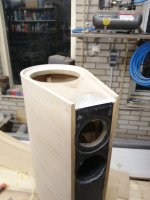Were you able to correct this dip with a crossover correction?also, i have some trouble where the mid and high have a big dip of 10 dB at 3 a 4 kHz. any ideas where this comes from?
the graph below are the raw measurements, yellow is tweeter, green is mid. (IR window of the impulse at 8.2 ms for eliminating reflections.)

it is not corrected in the crossover. i have experimented with dsp correction, but i got a lot of distortion when trying to completely remove the dip. it sounded much better after correcting it less than half of full dip.
Hi @ImpatientIcecream, how did you construct the protective frames? They are slim but have long sides which must not bend.
The front grill is constructed of 9mm mdf. The cutouts for the drivers are pretty small to retain some structural strength. For the finish the mdf got a coat of mat black spray paint and stretched speaker cloth around it. I attached the cloth by using a staple gun. The front speaker grill is mounted by magnets that are incorporated in the baffle and the grill.Hi @ImpatientIcecream, how did you construct the protective frames? They are slim but have long sides which must not bend.
The top is made of 18mm mdf and has the same finish as the front grill. What's cool about the top is that is recesses into the curved outside walls.
Attachments
You ever thought of laying up that shape in fibreglass then veneering it, the form wouldn't be to hard to make with some thin galv sheet and some wood framework holding it in shape, Id make it an outer form moulding it on the inside leaving a nice smooth surface to veneer too.
Haven't thought of that solution! It would require a design change for the exposed sides of the curved section but could significantly reduce fabrication time.You ever thought of laying up that shape in fibreglass then veneering it, the form wouldn't be to hard to make with some thin galv sheet and some wood framework holding it in shape, Id make it an outer form moulding it on the inside leaving a nice smooth surface to veneer too.
